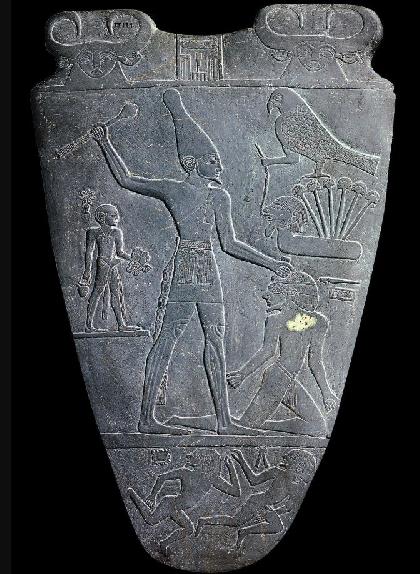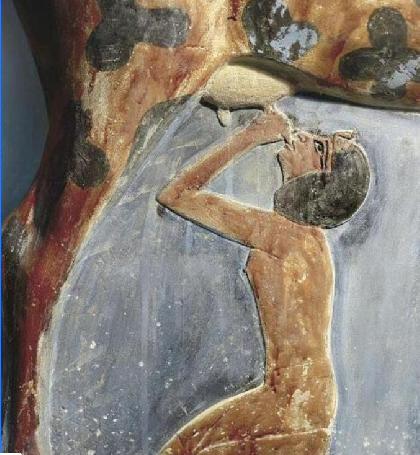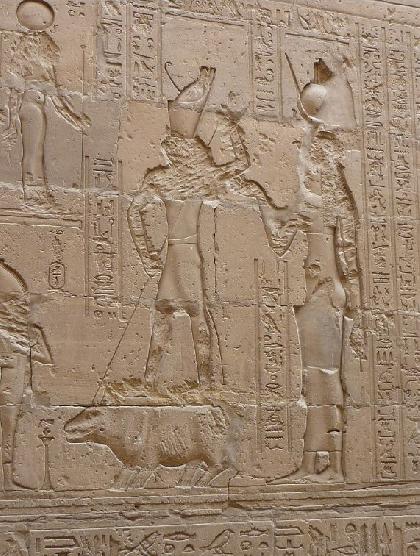
Hathor in the ancient Egyptian religion was presented as the Earth mother who was called in the Coffin Text "the Primeval or the Lady of All". The origin of Hathor is a highly controversial issue since some of the myths say that she came to the world at the same time with Ra and thus was regarded as the goddess of Sun and was always depicted as a black-skinned or reddish-black goddess. Yet other versions demonstrate that she was the daughter of Nut and Ra. One of the major myths say that she was the wife of Horus when he became the sun god and she was placed next to him on the solar boat with a solar disk over her head. The statue of Hathor and her pictures beautify the walls of many temples in Egypt. The temple of Ramsses II in Abu Simbel that he dedicated to Queen Nefertari and supplied it with a lot of the marvelous pictures of Hathor. The temple of Dandara is one of the major places that display the statues and pictures of this goddess since it was the center of its worship. The temple of Phyla in Aswan is another place that was established as a cult center for Hathor also and stands next to another one for the worship of Horus. The temple of Hatshepsut in Luxor also is rich with paintings for Hathor surrounded by the queen and other members of her family. One of the worth seeing statues of Hathor, is currently displayed in the Egyptian museum in which it is portrayed as a cow nursing the baby who was Amenophis II. Another statue for her with a wooden head of a cow with copper corns and eyes that look like those of Horus is shown in the Museum of Luxor.

- The Forms of Hathor
Among the depictions of Hathor the one that presents her as a cow and other times as a woman with the head of a cow. Another attractive form of Hathor is the one where she is depicted as a complete woman with a couple of horns holding the solar disk between them over her head. On the columns in the temples of Dandara and Phyla or Elephantine Island Hathor is portrayed as a remarkably beautiful woman with cow ears, and smiling face. In the Coffin Texts Hathor was presented as the goddess of love, music, dance, singing and beauty. This demonstrates the reason for using her usually as a symbol for pleasure and relief since she was the symbol of the wife, the daughter, and the woman in general. In the Book of the Dead, she was one of the goddesses who attend the trial of the dead people to testimony that they were fairly judged. Some of the paintings of her highlight the role she played in the underworld as the goddess who supplies the recently dead souls with food embodying her under the sycamore tree feeding the dead people who are sitting in the shadow of the There are some papyri that date back to the 21 dynasty that presents Hathor as the cow who stands in the entrance of the underworld greeting the dead souls. Some of these papyri relate between the rising and setting of the sun and the movement of the head of the cow that stands in the western mountain. In other paintings Hathor was wearing the menat necklace that was used as a symbol for resurrection and was known at that period as the Lady of the West and the Lady of the Holy Country. The ancient idea that Hathor represented the sky and was associated with the sun was here connected with her newer role in behalf of the dead at the entrance of the underworld. Hathor as the goddess of music was depicted as a woman with a round face and holding a musical instrument in her hand.
- The Family of Horus and Hathor

There are many myths that present the relation between Horus and Hathor and most of them contradict each other. Some of these myths present Horus as the son of Hathor and Hathor as the cow who supports the sky with her legs and in whose mouth Horus, the god sun, enters by the end of every day and comes out every morning. Of all these myths, the most well known story is the one saying that Horus was the husband of Hathor. This myth dates back to the Ptolemaic period and there are some spells that were uttered in the celebration of their marriage. It says that Horus married her after defeating his uncle Seth and being the heir of his father on the throne of earth and being identified with Osiris. It began when Hathor moved from her temple in Dandara and went to Horus in his temple in Edfu. The first day of celebration was the first day of spring and thus the celebration involves some events including the first fruits to be reaped and many other ceremonies and they passed the night in the Birth temple. The celebration lasted for about two weeks and many sacrifices and rituals had been made. Like any other festival in ancient Egypt the mortal humans were celebrating with singing, dancing and drinking win as it is depicted on the walls of the temples. Some of the ceremonial events were used symbolically to show that the enemies of Horus were killed and to announce him the ruler of the Upper and the Lower Egypt and the husband of Hathor. After the end of the celebration Hathor turned back to her temple in Dandara.
- Hathor Amulet
Hathor is also a mother goddess who protected women and children. Her name means 'Mansion of Horus.' Hathor was goddess of love and music; she is shown as a cow and often wears a headdress of horns and a disc. Placed on the chest in the row of gods .
